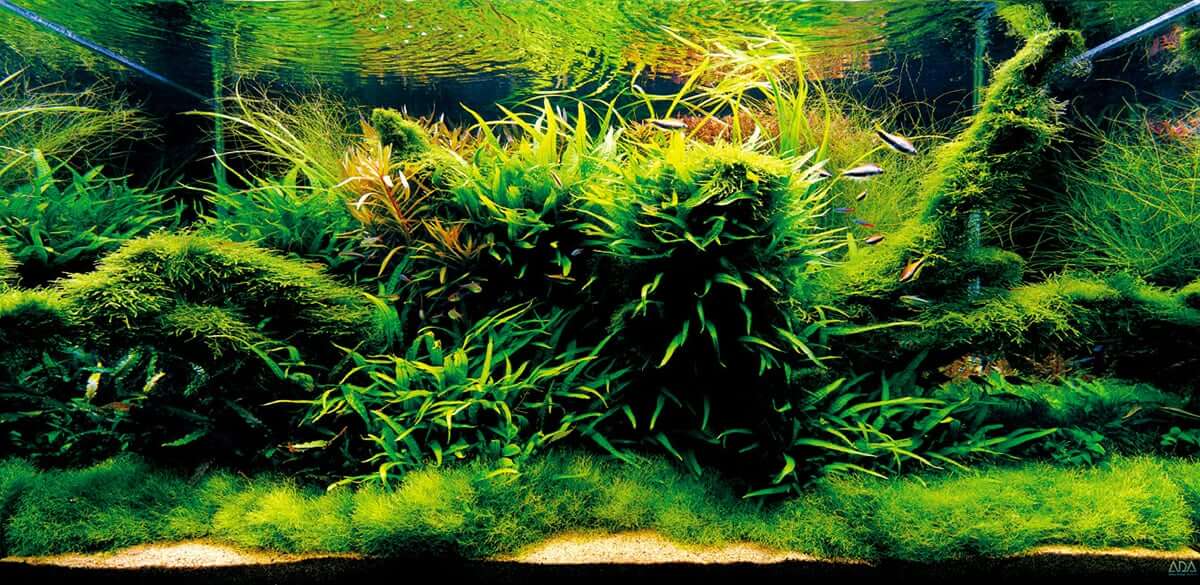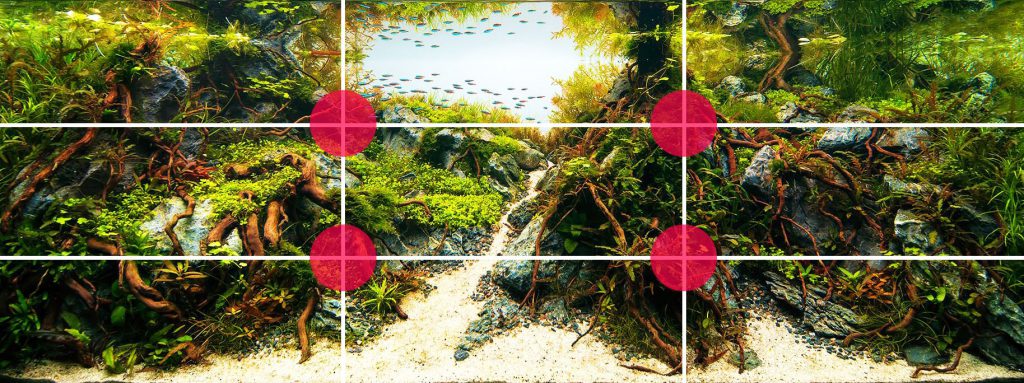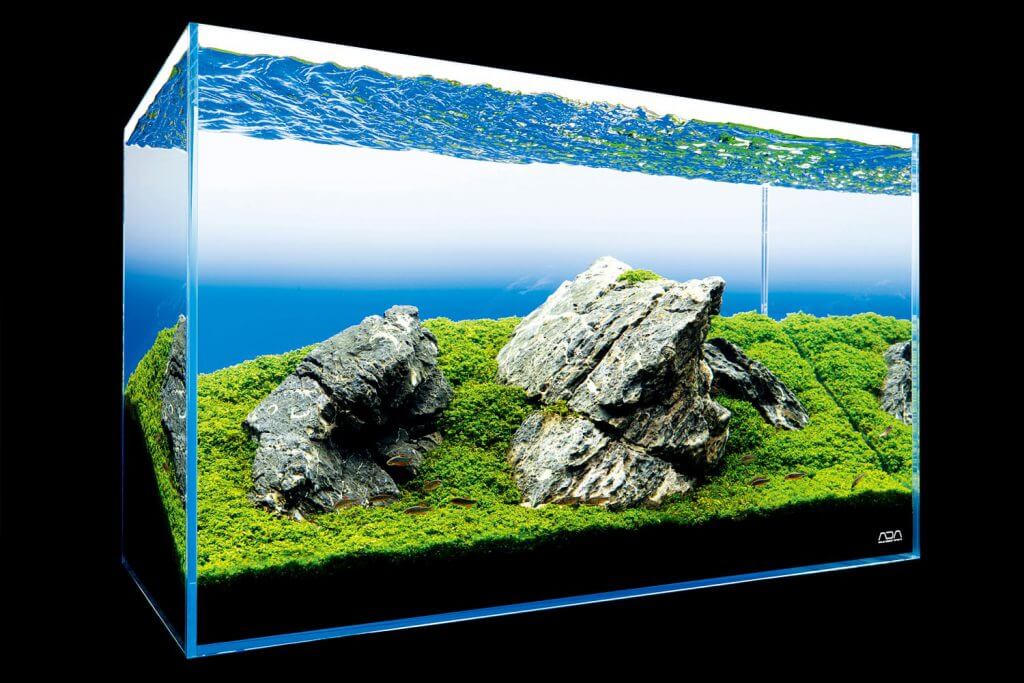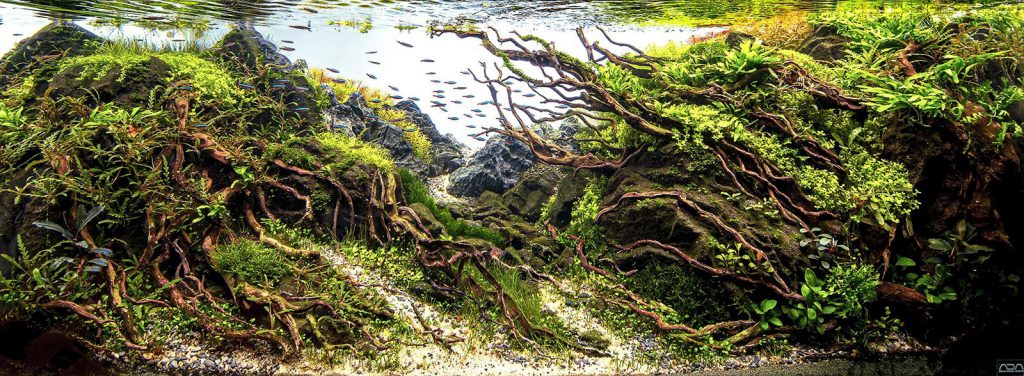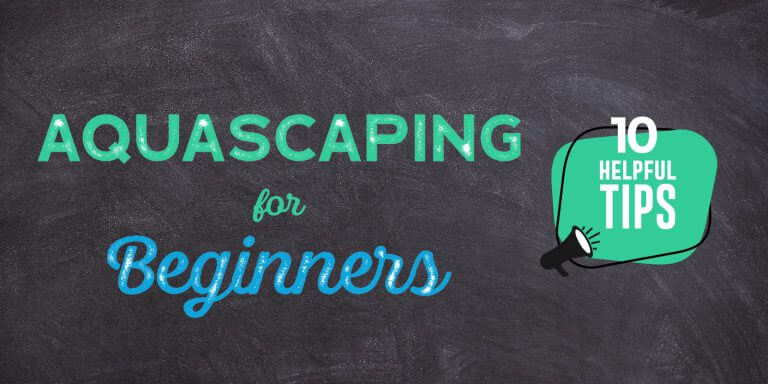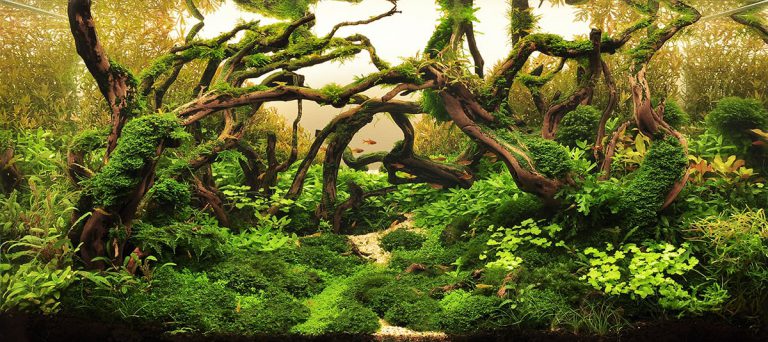Getting started with aquascaping is not difficult. Like any other passion, it takes time, dedication and extensive research. The following article aims to depict the basic knowledge related to aquascaping, from establishing the simple principles and rules of visual construction and setup, to introducing the essentials of building an aquascape, developing on the best known types of planted aquariums and, of course, offering valuable tips and suggestions regarding aquascaping composition and layout.
What is Aquascaping?
The craft of aquascaping has become increasingly popular in recent years. A comprehensive definition of the term describes aquascaping as ‘underwater gardening’, involving techniques of setting up, decorating and arranging a set of elements – aquatic plants, stones, driftwood, rocks, etc – in such a way that it becomes aesthetically pleasing to human perception.
Yet, differentiating from basic gardening, aquascaping involves a much longer and possibly more difficult path of development. Let’s face it, passionate aquarists know that fishkeeping is more than just growing fish and aquariums do not only display one’s interest in beautiful and fascinating species of aquatic organisms. Once aquariums have become part of our homes, they turn into our pride, they emerge in our daily conversations, and they fulfill our hidden dreams by enabling us to parade our creativity and imagination.
Besides the growing aspect of aquatic horticulture, involving the physiology, pruning, ecology and aquarium maintenance, aquascaping also implies aspects regarding design and layout, which extent beyond the boundaries of the aquarium itself. It’s not an easy task to obtain the perfect aquarium, but once you have decided to get into it, aquascaping can be fun, very challenging and rewarding.
Basic Aquascaping Principles
The whole aquascaping process may seem difficult to accomplish, but it’s not as hard as it looks if you follow a simple set of principles.
Like in the case of any creative development, aquascaping commits massively to a reliable knowledge resource and relies heavily on your imagination. Obtaining the perfect balance between efficiently used scientific principles and creativity is possibly the hardest to achieve.
Here is a couple of criterion one has to take into account before even thinking of getting started with aquascaping:
- Simplicity – Aquascaping is all about taste and usually, less elements is more. Very often people are tempted to incorporate as many types of plants as possible, thinking that this would ensure a great visual variety, but most of the times the result is the opposite.
- Variety – Keeping it simple does not mean using one type of plant only. Even if your intention is to create a theme, you don’t want your aquascape to look boring. Remember, imagination plays a key role in aquascaping!
- Proportion – It’s very important to give a sense of harmony to your tank, so try to have as much open space as filled space. Avoid using only large leaf plants because they take from the proportion and depth of your aquascape.
- Persistence – Aquascaping can become frustrating, be sure of that! So be ready to deconstruct and reconstruct if there’s something you don’t like about your aquascape. The more you experiment, the better you will get at it.
Aquascaping Hardware and Natural Elements
- Lighting – One of the most important pieces of aquascaping equipment, with crucial influence upon the health and growth of the aquascape plants, the lighting is considered to be the functioning heart of an aquarium.
- Water filters – As their name says it, the purpose of water filters is to remove excess food, the fish’s waste, dangerous chemicals and decaying organic matter within the aquarium. There are three basic methods you can filter water: mechanical, biological and chemical, and most water filters on the market involve a combination of two of them.
- Carbon Dioxide – The CO² systems might be slightly costly, but they are essential for the growth of plants. No plant grows without carbon dioxide, period. Those who are truly passionate about aquascaping think for the long term and know that purchasing a good CO² system enables them to grow their plants to their full potential.
- Liquid fertilizers – Think of fertilizers as of vitamins and minerals your body needs to stay hearty and strong. Depending on the lighting and CO² systems of the aquarium, there are two types of fertilizers you can use to keep it healthy: macronutrients and micronutrients. They both need to be dosed properly to create an appropriate aquatic environment.
- Substrate – Aquascape plants feed not only through their leaves, they also feed through their roots, which makes a correct selection of aquascaping substrate very important. Depending on the plants you want to grow (small foreground, tall background etc) the right substrate will ensure their proper size, development and color.
- Hardscape materials (aquarium driftwood and rocks) – You know how you say about a person that she’s beautiful because she has an amazing bone structure? This is what ornaments represent in aquascaping. The plants are not enough to secure the aesthetic of an aquarium. You need to add rocks, wood, gravel etc, make them look as unique as possible, and arrange them in an unusual yet attractive way. Hardscape materials are the essential elements which ensure the design and layout part of the entire aquascaping process.
Elemental Rules Concerning Aquascaping Visual Construction and Setup
Aquascaping may be a form of art in which imagination and creativity play an essential role, but mastering the backbone of this process is elementary if you want to be successful.
Measure is very important in nature, and aquascaping makes no exception. You want your tank to not only please your eye, but make it wonder in the right places. You want your fish to feel comfortable; you want your plants to grow to their full potential.
You can do all that by following a set of truly mathematical rules. Yes, before being wonderful, unpredictable and diverse, nature is mathematical.
The Rule of Thirds
It is true beauty stands in the eye of the beholder, but it is also true the eye of the beholder can be easily controlled. Any artist knows it and takes advantage of it. Aquascaping is all about creating enchanting visuals by suggesting the eye where to look at first and what to glide towards next.
The rule of thirds refers exactly at how we can use imaginary guidelines so that we know how to place certain elements within our scape in such a way that we are able to control what the eye of the viewer sees.
In order to understand how the rule of thirds works, try depicting an image as divided into nine equal parts by two equally spaced horizontal lines and two equally spaced vertical lines.
The purpose of these imaginary lines is actually to locate the intersection points of the grid, where you can establish the focal point of the image, a specific mark which anchors the viewer’s gaze first and from which the viewer’s eye can glide towards other points of interest, making the viewer’s experience more interesting, captivating, relaxing and pleasing.
Placing the focal point in the middle of your tank would take away from what is happening around.
The Golden Ratio in Aquascaping
Simply put, the golden ratio is a number obtained by dividing a line into two parts in such a way that if you divide the longer part by the smaller part the result is equal to the whole part divided by the longer part.
In both art and mathematics as well as in nature, the golden ratio is strictly connected with the creation of a focal point. In aquascaping, this would be the point the eye is directed towards at a first glance.
The Focal Point
As mentioned before, the focal point functions as an anchor for the viewer’s mind. It basically tells him where to look at first and where to go from there. Every aquascape should have a focal point. In the case of smaller tanks, there should be only one focal point and several secondary points of interest.
When it comes to larger aquariums, it is necessary that you create more than one focal point, out of which one should still remain the main attraction. It is very important to avoid stressing the eye, so having too many points of interest of the same importance wouldn’t be a good idea.
The most renowned styles of aquascaping make use of the rules described above. Whether we are talking about the Nature Aquarium, Iwagumi or Jungle style, they all start with the creation of focal points by implementing the golden ratio rule.
Aquascaping Styles
Like any form of art, aquascaping offers a variety of approaches and styles. Each person has their own taste and their own expectations and desires from their scaped aquariums.
There are four major types of aquascapes, each of them having particular characteristics and unique features: The Dutch style, the Jungle style, the Iwagumi style and the Nature Aquarium style. Below is a short description of these four main styles.
The Dutch Aquarium
Popularized in the 1930’s in the Nederlands, with the marketing of the first aquarium equipment, this aquascaping style is entirely focused on the culture and arrangement of aquatic plants.
The Dutch style does not involve the use of driftwoods or any hardscape materials. The main focus is placed on the height, colour and texture of a wide variety of plants and the basic technique of construction is the terracing approach.
It may look easy to accomplish, but the truth is aquascapers need to possess a great quantity of knowledge regarding different plants in order to create an aesthetically pleasing aquascape.
Read more about the Dutch Aquarium.
The Jungle Style
This is one of the simplest aquascaping styles to reproduce. As the name itself says it, the final product should resemble the wild, untamed appearance of a jungle.
One of the most common characteristics of the Jungle scaped tanks is that vegetation is often left to its own device and it becomes quite dense, which means it requires less maintenance and enables the scape to last longer.
The Jungle style aquascape may not be the most complex of layouts, but it can become very attractive and functional over time, as numerous fish species prefer its dense vegetation environment.
Read more about the Jungle Style Aquascape.
The Iwagumi Style
As opposed to the Dutch style, which only makes use of plants, the implementation of the Iwagumi aquascaping style is based on the development of an arrangement of rocks (hardscape), their positioning being particularly careful.
The use of low-growing plants is very common in order to enhance their natural beauty and their disposal. The typical setup for an Iwagumi aquascape involves the use of three main stones, out of which a larger one, called the big Buddha and two smaller stones (attending stones.
In order to create a sense of unity and harmony to the tank, it is important to use stones having the same color and texture.
Read more about the Iwagumi Style Aquascape.
The Nature Aquarium Style
This aquascaping style was introduced by Japanese Takashi Amano in the 1990’s and it is characterized by a very natural look and feel.
Differentiating from the Dutch well manicured garden style, the Nature Aquarium style aims to create a scape that resembles a landscape or image from the natural world.
Most common Nature Aquarium aquascapes depict miniature versions of rainforests, mountains, hillsides or valleys. Both hardscape material (wood, rock) and plants play an important role in the quest for balance in the aquarium.
Read more about the Nature Aquarium Style Aquascape.
Other Tips and Suggestions Regarding Aquascaping Composition
Now that we have addressed the mathematical aspect of aquascape construction and we have gone trough the most known aquascaping styles, it is time to accost the other things that contribute to the creation of beautiful, magnificent aquascapes.
Imagination and Creativity
Building your own aquascape is the perfect opportunity to set your imagination and creativity free. Start by doing your research, explore what others have done and experiment with new stuff.
The process of creation is a consuming act, but the reward is more than satisfying. Remember: you should follow the basic rules and principle of aquascaping, but in the end, it is your work, your tank, your imagination, you should be the first to like it.
Symmetry and Shape
Don’t strive to obtain symmetry in your tank! Nature isn’t perfect and that’s exactly what makes it beautiful. Avoid placing big chunks of hardscape material in the centre of the aquarium. It will make everything around look the same, taking away from the beauty of the entire piece.
The best aquascape shapes are the ones following a smooth curve. There are several composition styles in this regard:
- The concave layout – higher on either side and lower in the middle, this layout offers the impression of open space in the centre.
- The convex shaped layout – plants are trimmed lower on either side and higher in the middle, which is very nice aesthetically and can be obtained with rocks to make a mountain looking scape.
- The triangular setup – higher on one side, lower on the other, this type of layout creates very balanced visuals.
However, do not feel constrained by these basic shape setups! It’s far more important to let your creativity do its thing and experiment as much as possible. Follow your guts and listen to what your own eye tells you. Be confident and have fun in the process!
How to Create Perspective in a Planted Tank
1. Choose the Perfect Background
Unless you place your aquarium in the middle of a room, you should definitely give it a background. Some of the most common materials for aquascaping background include wood, cork, adhesive foliage or simple paint.
The role of the background is to hide the wall, hoses and cables and to help create in-depth perspective.
2. Find the Right Balance Between Foreground, Middle ground and Background
A good balance between these three can give a good aesthetic perspective to the tank. Use stones and driftwood in the midground to create the impression of hills or higher ground.
To obtain some in-depth, use low growing plants in the foreground and try some pieces of wood sticking out to the surface in the background. The final setup should make your aquascape look harmonious.
3. Choose a Natural Looking Substrate
Depending on the plants you intend to grow in your tank, you should choose natural looking gravel. The substrate acts as a base for the entire aquarium and you don’t want it to look artificial.
4. Choose the Right Plant coloration and Size
Planting the tank is very challenging, but quite fun. Make sure you begin with the focal point of your aquarium, continue with the lowgrowing and midgrowing plants and, at the end, with the higher ones.
It is better to plant groups very dense as well, the more items, the higher the chances to catch roots and develop. Use plants with different colors and sizes, as it will help you create contrast and indepth perspective and will help your tank look more natural.
Recommended Fish for Aquascaping Setups
Most people already have in mind what fish they want to put in their aquariums. When it comes to aquascaping, getting the right type of fish is a delicate choice, because there are many factors that need to be taken into consideration.
There is no specific rule, but you have think of their behavior, their breeding cycles, swimming habits and so on. You should avoid fish that would disturb your aquascape.
The most common types of fish are small and usually schooling (tetras, Australian rainbow fish etc) because they have nice bright colours and they make the tank look bigger.
Aquarium Maintenance
It’s not enough to build an amazingly looking aquascape. Keeping it clean and safe for the plants and fish could be as challenging.
Successful aquascaping really is depended on the things you do after you’ve set up your tank, things like regular pruning and waterchanging, constant plant trimming, correct balancing of light, CO2 and nutrients.
Enjoyed this article? Spread the word by sharing it with your friends!

